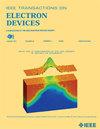High-Performance ZrO₂/β-Ga₂O₃ (001) Metal–Insulator–Semiconductor Capacitors
IF 2.9
2区 工程技术
Q2 ENGINEERING, ELECTRICAL & ELECTRONIC
引用次数: 0
Abstract
In this study, we have fabricated high-performance metalinsulatorsemiconductor (MIS) capacitor using atomic layer-deposited ZrO2/beta-gallium oxide (高性能ZrO₂/β-Ga₂O₃(001)金属-绝缘体-半导体电容器
在本研究中,我们利用原子层沉积ZrO2/ β -氧化镓($\beta $ -Ga2O3)(001)异质结制备了高性能的金属绝缘体半导体(MIS)电容器。研究了ZrO2/ $\beta $ -Ga2O3异质结的能带对准和ZrO2/ $\beta $ -Ga2O3 MIS电容器的电学性能。x射线光电子能谱(XPS)技术测定ZrO2/ $\beta $ -Ga2O3异质结的价带偏移($\Delta {E}_{V}$)和导带偏移($\Delta {E}_{C}$)分别为- 0.42和1.42 eV。其带向结构呈II型(交错间隙)结构。研究了ZrO2/ $\beta $ -Ga2O3 MIS电容器的栅漏电流和频率相关电容电压(C-V)特性。ZrO2/ $\beta $ -Ga2O3 MIS电容器具有较低的栅漏电流。采用PooleFrenkel (PF)导通模型来解释栅漏电流机理。基于频率相关的C-V特性,没有观察到显著的频率色散。计算得到ZrO2薄膜中的固定电荷和捕获电荷密度分别为$7.9\times 10^{{12}}$和$1.27\times 10^{{12}}$ cm $^{-{2}}$。在$\beta $ -Ga2O3导带下方能量为0.6 eV时,提取出的最小界面捕获电荷密度为$4.1\times 10^{{10}}$ cm $^{-{2}}\cdot \text { eV}^{-{1}}$,代表了电介质/ $\beta $ -Ga2O3(001)界面的最低报告值。这些结果表明,在$\beta $ -Ga2O3上形成了高质量的ZrO2薄膜,使其成为$\beta $ -Ga2O3功率器件中栅极介电材料的潜在候选材料。
本文章由计算机程序翻译,如有差异,请以英文原文为准。
求助全文
约1分钟内获得全文
求助全文
来源期刊

IEEE Transactions on Electron Devices
工程技术-工程:电子与电气
CiteScore
5.80
自引率
16.10%
发文量
937
审稿时长
3.8 months
期刊介绍:
IEEE Transactions on Electron Devices publishes original and significant contributions relating to the theory, modeling, design, performance and reliability of electron and ion integrated circuit devices and interconnects, involving insulators, metals, organic materials, micro-plasmas, semiconductors, quantum-effect structures, vacuum devices, and emerging materials with applications in bioelectronics, biomedical electronics, computation, communications, displays, microelectromechanics, imaging, micro-actuators, nanoelectronics, optoelectronics, photovoltaics, power ICs and micro-sensors. Tutorial and review papers on these subjects are also published and occasional special issues appear to present a collection of papers which treat particular areas in more depth and breadth.
 求助内容:
求助内容: 应助结果提醒方式:
应助结果提醒方式:


